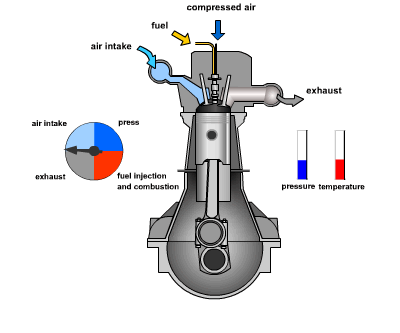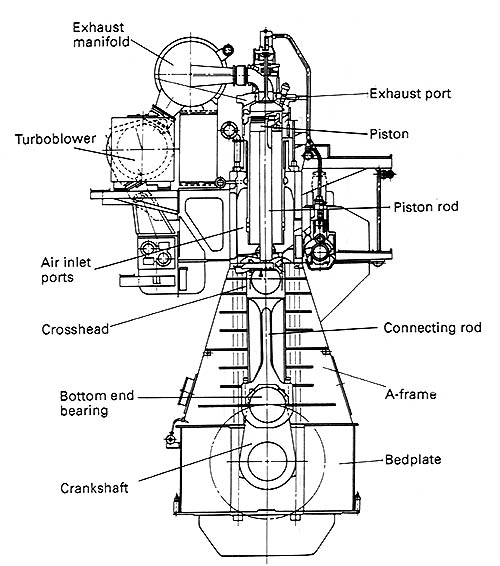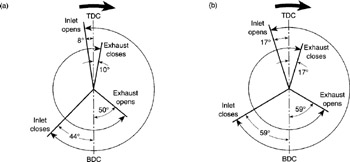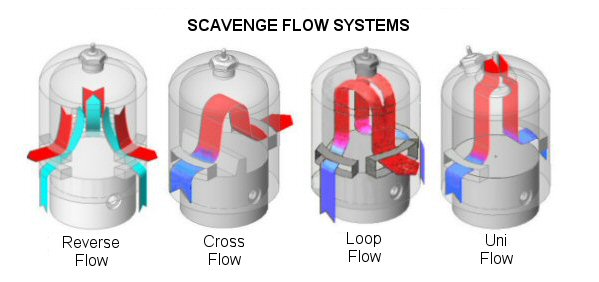Now that we have learnt about engine classification let's now try and understand Engine Timing and associated Terminology.
What is meant by Engine Timing?
Engine timing is the determination of what happens when inside an engine cylinder i.e at what position and at what instance we have Induction, Compression, Ignition and Exhaust. If all these strokes don't happen at the prescribed/designed time and instance than the engine will not work as it should.
Lets take a simple example.
If we are not experiencing ignition of fuel at a position of piston where it normally occurs than we are likely to experience unfavorable combustion and poor engine performance. As a result it becomes very important for us to understand as to what is happening when inside an engine cylinder so that we can troubleshoot accordingly.
So what all timing cycles are we looking at?
Universally all the engines have 5 cycles i.e. INDUCTION, COMPRESSION, IGNITION, EXPANSION and EXHAUST . Let it be 4 stroke engine or 2 stroke engine, both of hem have to undergo these 5 cycles.
So what's the meaning of these 4 cycles?
INDUCTION - The induction system provides the engine with an adequate supply of clean air for good combustion (and for scavenging cylinders on two and four stroke-cycle engines) for all operating speeds, loads, and operating conditions.
COMPONENTS WHICH ARE LIKELY TO BE FITTED IN AN INDUCTION SYSTEM
- On a naturally aspirated four-stroke-cycle engine, the system includes the air cleaner, a precleaner (if used), the intake manifold, and the connecting tubing and pipes
- On the two-stroke cycle engine, the system also includes a blower for scavenging air and for combustion. A four stroke engine may also have a blower.
- On a turbocharged engine, additional air is supplied by means of a turbocharger, which is exhaust gas–driven.
- On a supercharged engine a mechanically driven blower is used to supply additional air. An air shutdown valve may be included to allow engine intake air to be shut off completely for emergency engine shutdown.
- An intercooler or after cooler may also be included in the induction system. Since cooler air is more dense, a greater amount of air is in fact supplied if the air is cooled.
- The intercooler is mounted to cool the intake air after it leaves the discharge side of the turbocharger and before it enters the engine (before it enters the blower on two-stroke-cycle diesels).
- The after cooler is mounted in the two stroke- cycle diesel engine block so that it will cool intake air before it enters the cylinder ports. Air-to air aftercoolers are mounted in front of the radiator.
At this point it becomes important for us to understand the meaning of these 5 terms:
- INTER COOLER - Is an air cooling device which is placed between the Engine turbocharger or Supercharger and the engines air intake manifold.
- AFTER COOLER - Is an air cooling device which is placed between the LAST Engine turbocharger or Supercharger in series and engines air intake manifold. After Cooler is the last cooling stage before the engine. We can only say that intercooler is connected between the turbochargers/superchargers in series and the last intercooler which is connected to the engines manifold is called the After Cooler. Therefore Intercooler is After cooler.
- RADIATOR - Radiators are heat exchangers which can be used for heating as well as cooling. Radiators are mainly used in cars and are used for cooling the water which circulates around the engine.
- SUPERCHARGERS - Supercharger is typically driven by a belt or a gear powered by the engine. superchargers are good because the horsepower boost is available immediately however supercharger takes the power away from the engine.
- TURBOCHARGERS - The turbocharger creates pressure using the already-burnt exhaust gas that is coming out of the engine to turn the blades of a fan that forces the air into the engine. Turbocharger takes a moment to "spool up" from the exhaust gas. Turbocharger does not take power away from the engine.
COMPRESSION - Means the reduction in volume and increase in pressure of the air or combustible mixture in the cylinder prior to combustion. This is achieved by piston which is moving upwards in cylinder. Also compression of gas naturally increases the temperature.
IGNITION - Means the act of igniting fuel in cylinder. The fuel is injected into the cylinder through fuel injectors and this is ignited by either a spark plug or by the heat produced in the cylinder due to compression.
EXPANSION - After the ignition the combustion occurs in the cylinder which is nothing but a "blast" which causes a rapid expansion of gases which causes the piston to move downward.
Now in many texts you will find one more stroke called the power stroke which defines that blast which occurs in cylinder. This blast is what defines the intensity of combustion occurring in the cylinder meaning if we were to measure the value of this blast, the greater the value higher the pressure in the cylinder.
EXHAUST - Also there exits another stroke which is called the Exhaust stroke which happens, where all the burnt gases are removed from the cylinder due to the upward movement of the piston.
We can measure certain values within a cylinder to determine the condition of combustion which are PEAK PRESSURE and COMPRESSION PRESSURES. (we will look more into these two terms in my upcoming posts, but first we must understand the difference between two 2 stroke engine and 4 stroke engine)
2 STROKE ENGINE AND 4 STROKE ENGINE
In my previous post on ENGINE CLASSIFICATION we have seen that there exists 2 stroke and 4 stroke engines. Lets now first of all take a look at the differences between the two.
Lets try and keep this as simple as possible.
- A 2 stroke engine fires once every revolution where as 4 stroke engines fire once every two revolutions.
- In a 2 stroke engine compression stroke is followed by ignition of compressed air and fuel and on the return stroke the same happens. In 4 stroke engines there is 1 compression stroke and 1 exhaust stroke. In compression stroke the fuel/air mixture is compressed prior to blast where as in exhaust stroke the burnt gases are simply pushed out of the cylinder.
- The firing frequency of 2 stroke engine is every revolution where as for a 4 stroke engine is once every 2 revolution.
- 2 stroke engines make use of cross heads while 4 stroke engines do not make use of cross heads. They have the connecting rod connected to the piston by means of gudgeon pin and hence do not have a piston rod.
- In a 2 stroke engine scavenging takes place during the latter part of the downward stroke i.e expansion stroke and the early part of upward stroke i.e compression stroke whereas in a 4 stroke engine scavenging takes place when the piston is nearing and passing TDC during the latter part of upward stroke (Exhaust stroke) and the early part of the downward stroke (intake stroke).
- Also majority of 2 stroke engines make use of inlet ports and not inlet valves unlike 4 stroke engines which make use of inlet valves.
- A major difference can be that of lubrication. 2 stroke engines make use of forced lubrication when it comes to piston to liner motion where as 4 stroke engines make use of splash lubrication. Some of the 2 stroke engines make use of oil and fuel premix like the chain saw engines.
- Two stroke engines have higher power to weight ratio than 4 stroke engines
- Two stroke engines are easier and cheaper to build than 4 stroke engines
Ref to points 8 and 9 please note that there were small 2 stroke engines which were chainsaw engines used in bikes in the late 19th and 20th centuries. These engines were small compact engine with higher power to weight ratio. Now that these engines are obsolete points 6 and 7 no longer should be used when it becomes to distinguishing between 2 stroke and 4 stroke engines. (I have mentioned these points only because you will find them in many texts).
The only major difference between the two is that "2 STROKE ENGINE CAN PRODUCE TWICE THE POWER OF A 4 STROKE ENGINE OF SAME SIZED ENGINE AND SAME REVS".
 |
| THE 2 STROKE CYCLE WITHOUT CROSS HEAD |
 |
| 4 STROKE ENGINE WITH SPARK PLUG |
 |
| 4 STROKE ENGINE WITHOUT SPARK PLUG |
Diagram representing a typical spark plug engine
Above image source - how stuff works inc
 |
| Figure shows a typical 2 stroke engine with cross head |
Now that we have learnt the differences between a 2 stroke engine and 4 stroke engine it is now time for us to understand the TIMING CYCLE.
Always remember that each stroke is one half of a revolution or 180 degree of cam movement. All four strokes i.e 4x180=720 degrees represent two complete revolutions of the crank for a 4 stroke engine.
TIMING CYCLE OF A 4 STROKE ENGINE
Always remember that each stroke is one half of a revolution or 180 degree of cam movement. All four strokes i.e 4x180=720 degrees represent two complete revolutions of the crank for a 4 stroke engine.
TIMING CYCLE OF A 4 STROKE ENGINE
 |
| Timing diagram of a typical 4 stroke engine |
Lets now take a look what is happening here
INDUCTION STROKE - Inlet valve opens and the piston is moving from Top Dead Center (TDC) to Bottom Dead Center (BDC) at the end of exhaust stroke. In this stroke air is either sucked into the cylinder due to the build up of negative pressure as the piston is moving down or forced into the cylinder by means of a turbocharger.
Inlet valve is made to open 8 degrees to 17 degrees before the piston reaches TDC as show in the figure above, however this value may vary from engine to engine and it can range from 5 degrees to 30 degrees as per engine design. This is called Inlet valve opening lead.
Here the question arises "WHY THE INLET VALVE IS OPENING BEFORE THE PISTON REACHES THE TDC"?
The valve is made to open before the piston reaches the TDC because of the following reasons:
- The opening area of the valve is very small once the valve opens i.e leaves the seat
- As the opening area of the valve is small therefore the intake efficiency is low as the intake resistance is high due to smaller opening area
- By the time valve would have opened (if it were to open at TDC), the piston would have moved considerably down the bore, and by the time valve will close, the opening of the valve would have been minimal
At the end of induction stroke Inlet valve is made to close after BDC as shown in the figure above (44 degrees after BDC and 59 Degrees after BDC). This value can however range from 40 degrees to 60 degrees as per engine design. This is called inlet valve closing lag.
Here the question arises "WHY THE INLET VALVE IS CLOSING AFTER THE PISTON LEAVES THE BDC"?
The valve is made to close after the piston leaves the BDC because of the following reasons:
- Once the piston has reached the BDC the air pressure in the cylinder is still lower than the atmospheric pressure
- Air will continue to flow in the cylinder till the pressure inside the cylinder is lower than the pressure in the intake manifold
- Air intake can be increased by delaying the closure of the inlet valve at the end of intake stroke
- Delaying the closure of the inlet valve forces more air or air/fuel mixture to be introduced into the cylinder in spite of the fact piston is moving upwards
This means that if the valve is made to close once the piston has reached BDC than we are introducing less air in the cylinder than the actual capacity of the cylinder and if we are to close the inlet valve a lot later than we are flowing the air back into the intake manifold.
COMPRESSION STROKE - Both the inlet and exhaust valves are closed and the piston is moving from BDC to TDC and the air or air/fuel mixture is compressed.
INJECTION STROKE - Fuel injection into the cylinder begins at 10 degrees to 18 degrees before TDC and closes at 10 to 20 degrees after TDC. This is done in order to ensure proper burning of the fuel.
This means that if the fuel valve is opened too early than we will have early ignition which will reduce power of the engine and if we have late injection than the chances of incomplete combustion are likely.
EXPANSION/POWER STROKE - In this stroke also inlet and outlet valves remain closed and the piston is moving from TDC to BDC. This happens because of the Blast that occurs due to the ignition of air/fuel mixture in the cylinder.
EXHAUST STROKE - Exhaust valve opens and the piston is moving from TDC to BDC and the exhaust gases are expelled out of the cylinder.
Exhaust valve is made to open 50 degrees to 59 degrees before BDC as can be seen in the figure above however this value can range from 40 degrees to 60 degrees as per engine design. This is called exhaust valve opening lead.
Question here now arises "WHY THE EXHAUST VALVE IS OPENING OPENING BEFORE THE PISTON REACHES BDC"?
The valve is made to open before the piston reaches BDC because of the following reasons:
- This prevents the exhaust gases from preventing a high pressure cushion on the piston
- This high pressure cushion would restrict the movement of the piston
- This restriction would take off a certain amount of power from the engine
- Also because of the resistance of the exhaust gas pressure (back pressure), after the piston has passed the BDC the losses on the piston increases
At the end of exhaust stroke exhaust valve is made to close 10 degrees and 17 degrees after the piston has crossed TDC as shown in the figure however this value can vary from 10 degrees to 30 degrees as per engine design. This is called exhaust valve closing lag.
Question here arises "WHY THE EXHAUST VALVE IS CLOSING AFTER THE PISTON LEAVES THE TDC"?
The valve is made to close after the piston leaves TDC because of the following reasons:
- We do not want any exhaust gases left in the cylinder before the start of next cycle
- If exhaust gases are not fully removed from the cylinder than we are inviting problems in the combustion cycle
Now what have we missed out here?
If we look into the diagram we can see that both the inlet valve and the exhaust valves are open at the same time i.e the inlet valve opens before TDC and exhaust valve closes after TDC. Now the duration for which these two valves remain open is called VALVE OVERLAP.
Now what's the use of VALVE OVERLAP?
Valve overlap ensures that the exhaust gases rushing out of the cylinder creates suction, in order to draw in fresh air or air/fuel mixture and the fresh mixture entering the cylinder pushes out the exhaust and give a scavenging effect.
This means that an early overlap may cause exhaust gases being expelled into the intake manifold and a late overlap may cause exhaust gases being drawn back into the cylinder.
Having learnt about the timing cycle of a 4 stroke engine let's now take a look at 2 stroke engine timing diagram.
TIMING CYCLE OF A 2 STROKE ENGINE ( A 2 STROKE ENGINE WITH SCAVENGE PORTS AND EXHAUST VALVE)
 |
| Figure shows a Typical 2 Stroke Cycle |
| Valve timing diagram of an engine with Loop Scavenging |
KEY - 1-2 - FUEL INJECTION TAKES PLACE (INJECTION STROKE)
2-3 - EXPANSION (POWER STROKE)
3-5 - EXHAUST TAKES PLACE (EXHAUST STROKE)
4-5 - SCAVENGING TAKES PLACE
4-6 - FRESH AIR IS ADMITTED (INTAKE STROKE)
6-1 - COMPRESSION (COMPRESSION STROKE)
Lets now take a look what is happening here.
A typical example of an engine with loop scavenging is Sulzer RLB
A typical example of an engine with loop scavenging is Sulzer RLB
 |
| Engine with Uni Flow Scavenging with exhaust valve Source - disel duck |
Lets see what is happening here
- As the piston is moving towards BDC after the power stroke, 110-120 degree after TDC, Exhaust valve opens and the exhaust starts to expel out of the cylinder
- Before BDC again at 130-150 degrees after TDC, the piston uncovers the scavenge ports in the cylinder, and the fresh air is introduced into the cylinder
- Here at this time both the exhaust valve and inlet ports are open and at this point scavenging occurs where the remaining exhaust gases are expelled out of the cylinder. This is called VALVE OVERLAP (we have seen this in the four stroke cycle as well)
- The air entering the cylinder is at a high pressure i.e greater than atmospheric pressure, this is supercharged air
- As the piston starts to move up at 130-150 degrees before TDC the scavenge ports close and the entry of fresh air is now stopped
- As the piston moves further upwards at 110-150 degree before TDC exhaust valve closes and the compression stroke starts
- At the end of compression, at 10-20 degrees before TDC ignition starts and fuel is now injected into the hot air in the cylinder which was compressed in the compression stroke
- Once the ignition has occurred, expansion occurs where the piston is pushed downwards and the entire cycle repeats itself
WHAT IS MEANT BY SCAVENGING and SUPERCHARGING?
Scavenging is the process in which air is forced into the cylinder which is called the scavenge air, through ports in the cylinder liner which are called the scavenge ports, which helps to clear the cylinder from gases of combustion.
Supercharging means an increase in air flow into the cylinders of an engine which serves to increase in power output, in addition to being used for scavenging. So basically what is happening is scavenging is done when the air is admitted into the cylinder under low pressure with the exhaust valves or ports open. Supercharging is done with the exhaust valve or ports closed where the air is forced to enter the cylinder and thereby increase the amount of air that is available for combustion. Therefore an engine is said to be supercharged when the scavenge manifold pressure exceed the atmospheric pressure.
Always remember an engine which is supercharged, of the same give size, can develop more power than an engine of the same size that is not supercharged.
Always remember, as explained above,
Always remember, as explained above,
- SUPERCHARGERS - Supercharger is typically driven by a belt or a gear powered by the engine. superchargers are good because the horsepower boost is available immediately however supercharger takes the power away from the engine.
- TURBOCHARGERS - The turbocharger creates pressure using the already-burnt exhaust gas that is coming out of the engine to turn the blades of a fan that forces the air into the engine. Turbocharger takes a moment to "spool up" from the exhaust gas. Turbocharger does not take power away from the engine.
Lets take a look at what happens when a 4 stroke engine is supercharged?
For a 4-stroke diesel engine to be super-charged, a blower must be added to the intake system since exhaust and intake in an unsupercharged engine are performed by the action of the piston. The timing of the valves in a super-charged 4-stroke cycle engine is also different from that in a similar engine that is not super-charged. In the supercharged engine, the closing of the intake valve is slowed down so that the in-take valves or ports are open for a longer time after the exhaust valves close. The increased time that the intake valves are open (after the exhaust valves close) allows more air to be forced into the cylinder before the start of the compression event. The amount of additional air that is forced into the cylinder and the resulting increase in horse-power depends on the pressure in the air box or intake manifold. The increased overlap of the valve openings also permits the air pressure created by the blower to remove gases from the cylinder during the exhaust event.
Having learnt about the meaning of Scavenging lets take a look at different types of scavenging.
- REVERSE FLOW - In this type of scavenging, there are two pairs of inlet ports, at the front and rear respectively, with two exhaust ports located on either side of the two pairs of inlet ports. In this type of scavenging the incoming flow of air spreads out like a fan which is deflected downwards and expel the exhaust gases.
- CROSS FLOW - In this type of scavenging, Intake and Exhaust ports are located on the opposite sides. The gases in a way flow across the head.
- LOOP FLOW - This type of scavenging occurs in engines which have exhaust ports just above scavenge ports. As the piston uncovers the exhaust ports at the end of power stroke, the exhaust gas starts to leave the cylinder. As the scavenge ports are uncovered by the piston, the scavenge air loops around the cylinder and pushes the remaining exhaust gases out of the cylinder.
- UNI FLOW - This type of scavenging occurs in engines which have exhaust valve located on the cylinder head. As the exhaust valve opens due to cam action, the exhaust gases are expelled out of the cylinder, and as the scavenge ports are uncovered by the piston, the scavenge air enters the cylinder and expels the remaining exhaust gases. This type of scavenging is quite common and is quite simple as the flow of air is in one direction that is from bottom to top.
A POINT WHICH MUST BE REMEMBERED BY EVERY ENGINEER:
There exists four stroke engines as well as two stroke engines which can have spark ignition.
There exists four stroke engines as well as two stroke engines which can have trunk type piston design.
There exists four stroke engines as well as two stroke engines which can have inlet and exhaust valves.
There exists four stroke engines as well as two stroke engines which can be turbocharged.
Engines where mixture of fuel and air is introduced into the cylinder are usually spark plug ignition type engines and engines where only air is introduced into the cylinder are usually diesel engines.
For information on Spark Ignition 2 Stroke engines please click here







